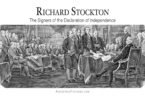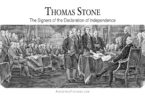William Paca was born in October of 1740 in Abingdon, Maryland. He came from what were fairly deep American roots at the time, with his great-grandfather, Robert Paca, coming to America from England by 1651. William’s parents were John Paca, who was a wealthy planter, and Elizabeth Smith. He was the second son in a family that included an older brother and five sisters. He married Mary Chew, the daughter of another wealthy Maryland planter, and they had three children together, though only one of them, a son named John Philemon Paca, survived past childhood.
William attended the Philadelphia Academy and Charity School when he was twelve, being homeschooled before that, then went to attend the College of Philadelphia (which is now the University of Pennsylvania).
William graduated from that college in 1759 with a Bachelor of Arts degree. In 1762, he obtained a Master’s degree from the same college. Interestingly, obtaining the Master’s degree did not require any additional study on Paca’s part. All he had to do was request the degree, and be in good standing with the college. After obtaining his Master’s degree, William went to London, England, where he attended the Inner Temple to study law. He was admitted to the bar in 1761, and entered private practice as a lawyer in Annapolis, Maryland in 1763.
William began his political career not long after setting up his legal practice. He was elected as a member to the lower house of the Maryland Proprietary Assembly in 1767, and served there until 1774. After that, he was selected as a delegate to the First and Second Continental Congresses, as a representative from Maryland. He served on the Congress until 1779, during which time he signed the Declaration of Independence.
After leaving the Continental Congress, William served on the Maryland Senate, and became a Judge of the Maryland General Court while still serving on the Congress, in 1778. William became a Judge of the Court of Appeals in Cases of Capture, and served in that job from 1780 to 1782. Then, from 1782 to 1785, William was the Governor of Maryland. After serving as Governor of the new state, he became a member of the Maryland House of Delegates. He was also a delegate to the Maryland Convention that ratified the new Constitution of the United States.
While serving as a private lawyer, before joining the Continental Congress, William became friends with Samuel Chase. The two men became close friends and political colleagues. Together, they led the local Maryland opposition to the British Stamp Act of 1765. They also established the Anne Arundel County chapter of the Sons of Liberty together.
After the American Revolution, William was granted a recess appointment from President George Washington to the United States District Court for the District of Maryland. Washington gave William an official nomination to that same position in 1790. The US Senate confirmed him to it a couple of days after, and William was presented with his official commission to that position the same day the Senate confirmed him. William served in this position the rest of his life, until he crossed to the other side in October of 1799. William made his crossing at his family estate called Wye River in Queen Anne’s County, Maryland, and was buried in the family cemetery on his estate.
William was an honorary member of the Society of the Cincinnati in Maryland, a membership he took up in 1783. He served as Vice-President of the Society from 1784 to 1787. Though he was a member, the Society of the Cincinnati does not accept memberships through him today, as he was an honorary member of the group and not a hereditary one. Only hereditary members are eligible to be represented in the group by a living descendant.
William’s house in Annapolis, which is today called the Paca House and Garden, was listed on the National Register of Historic Places in 1971, and was designated as a National Historic Landmark that same year. There is a William Paca Club in New Providence, New Jersey that is named for him. There is also a Paca-Carroll House at St. John’s College that is named for William and another fellow signer of the Declaration of Independence.
Interestingly, the William Paca Club is founded to celebrate him based on what has always been assumed to be a fact…that William was of Italian heritage, thus making him the only Italian-American signer of the Declaration of Independence. Yet, there is no proof of William having such a heritage. In fact, the assertion that William was of Italian heritage only came to be in 1911, when a citizen of Baltimore commented that he thought there was a relationship between the Paca family and the Pecci family in Italy. This rumor was further compounded when someone who claimed to be a descendant of William wrote to the New York Times in 1937 and claimed that the Paca family ancestors were of both Italian and English origin, with the name being originally spelled as Pacci.
It is true that the surname Paca has been spelled in a variety of ways in America, including as Peaker, Pecker, Peaca, Peca, and Paka. Italian spellings like Pecci and Pacci are not included in the list of the ways the surname has been spelled in America, though this could be attributed to the phonetic spelling of the past, before English had a standardized dictionary of spelling, and a name like Pecci or Pacci being challenging for English-speaking clerks to accurately spell using only the way it sounded when spoken.
There is currently no proof that William Paca was or was not of Italian heritage. What is clear is that if he did have Italian heritage, it was distant. Both his father and his grandfather were born in the American colonies. His great-grandfather was born in England in about 1632, and came to the colonies no later than 1651. This great-grandfather was known to have sometimes spelled his last name as Peaker, which is an English surname.







